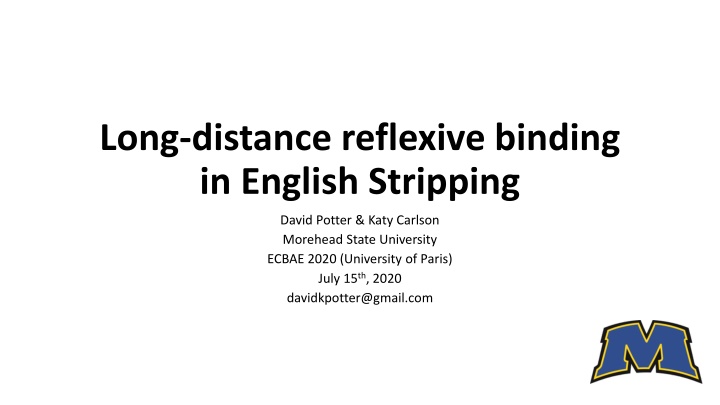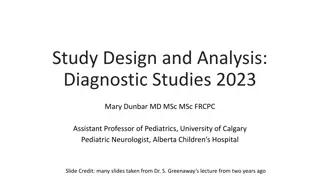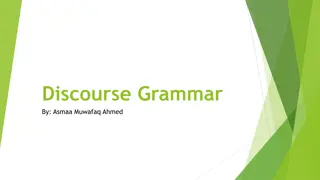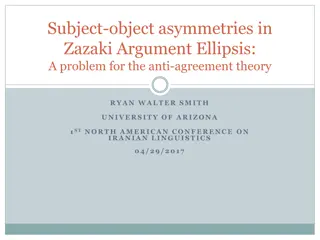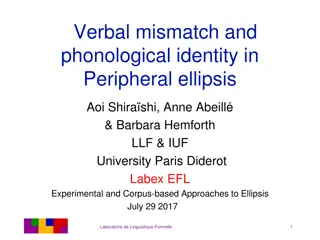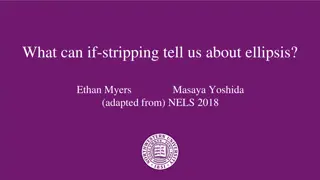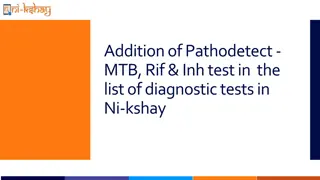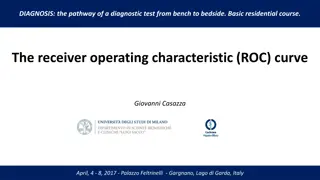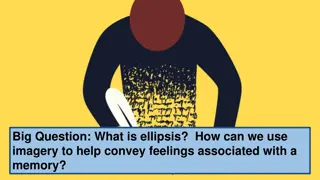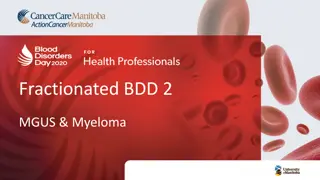Reflexives as Movement Diagnostic Under Ellipsis in English
Explore the syntax of ellipsis in English focusing on gapping, stripping, sluicing, and more. Understand reflexives as a movement diagnostic under ellipsis, examining scenarios where reflexives must have a c-commanding clausemate binder. Dive into experiments evaluating the plausibility of pronoun references in various linguistic contexts.
Download Presentation

Please find below an Image/Link to download the presentation.
The content on the website is provided AS IS for your information and personal use only. It may not be sold, licensed, or shared on other websites without obtaining consent from the author.If you encounter any issues during the download, it is possible that the publisher has removed the file from their server.
You are allowed to download the files provided on this website for personal or commercial use, subject to the condition that they are used lawfully. All files are the property of their respective owners.
The content on the website is provided AS IS for your information and personal use only. It may not be sold, licensed, or shared on other websites without obtaining consent from the author.
E N D
Presentation Transcript
Long-distance reflexive binding in English Stripping David Potter & Katy Carlson Morehead State University ECBAE 2020 (University of Paris) July 15th, 2020 davidkpotter@gmail.com
What is the syntax of Ellipsis? Gapping Stripping Sluicing VPE Nominal Ellipsis Fragment Answers Pseudo- Gapping LPE 2
What is the syntax of Ellipsis? 1a. Alex: Jordan called someone. 1b. Parker: Yeah, Jordan called Taylor. 1c. Parker : Yeah, Taylor. Stripping 2a. Jordan called Taylor. In-situ Ellipsis (Abe 2015; Ott & Struckmeier 2018) Remnant doesn t move Non-constituent elided 2b. Taylori Jordan called _i. Move and Elide (Merchant 2001, Potter 2017) Remnant moves Constituent is elided Alternative analyses: 2c. Taylor. 2d. . Taylori it was _i. Non-isomorphic Non-structural 3
Reflexives as movement diagnostic under ellipsis Binding Condition A: Reflexives must have a c-commanding clausemate binder 3a. The investigators assumed [CP that Taylor had misled herself]. 3b. *The investigators assumed [CP that Taylor had misled themselves]. BCA is relaxed in certain long-distance dependencies (Lebaux 1990; Heycock 1995; Fox 2003) 4. It was themselves who the investigators assumed that Taylor had misled _. 4
Reflexives as movement diagnostic under ellipsis 5a. The investigators assumed that Taylor had misled someone. 5b. Yeah, themselves. In-situ Ellipsis 6a. the investigators assumed that Taylor had misled themselves. 6b. * the investigators assumedthat Taylor had misled themselves. Move and Elide 7a. themselves the investigators assumed that Taylor had misled _. 7b. it was themselves who the investigators assumed that Taylor had misled _. 5
Experiment 1 8a. Alex: The investigators assumed that Taylor had misled someone. 8b. Parker: Yeah, the investigators assumed that Taylor had misled themselves. Task: Read dialogues and rate the plausibility of the underlined words to referring to the same person(Kazanina et al. 2007; Potter 2017; Yoshida et al. 2018) Platform: Amazon Mechanical Turk; N=40; 24 items Design: 2x3 Continuation type: Canonical, It-cleft, Stripping Pronoun type: Reflexive, Personal pronoun 6
Experiment 1 Antecedent 9. The investigators assumed that Taylor had misled someone. Prediction: 10b more plausible than 10a Canonical 10a. Yeah, the investigators assumed that Taylor had misled themselves. 10b. Yeah, the investigators assumed that Taylor had misled them. Prediction: 11a more plausible than 11b (Reeve 2013) It-cleft 11a. Yeah, it was themselves that the investigators assumed that Taylor had misled. 11b. Yeah, it was them that the investigators assumed that Taylor had misled. Stripping 12a. Yeah, themselves. 12b. Yeah, them. Predictions: In-Situ: 12b more plausible than 12a (= 10b v. 10a) M&E: 12b and 12a equally plausible 7
Experiment 1 Antecedent 9. The investigators assumed that Taylor had misled someone. Prediction: 10b more plausible than 10a Canonical 10a. Yeah, the investigators assumed that Taylor had misled themselves. 10b. Yeah, the investigators assumed that Taylor had misled them. Prediction: 11a more plausible than 11b (Reeve 2013) It-cleft 11a. Yeah, it was themselves that the investigators assumed that Taylor had misled. 11b. Yeah, it was them that the investigators assumed that Taylor had misled. Stripping 12a. Yeah, themselves. 12b. Yeah, them. Predictions: In-Situ: 12b more plausible than 12a (= 10b v. 10a) M&E: 12b and 12a equally plausible 9
Experiment 2 13a. Alex: The investigators assumed that Taylor had misled someone. 13b. Parker: Yeah, the investigators assumed that Taylor had misled themselves. Task: Acceptability judgments Platform: Amazon Mechanical Turk; N=44; 24 items Design: 2x3 Continuation type: Dependency length: Long, Short Canonical, It-cleft, Stripping 10
Experiment 2 Antecedent 14. The investigators assumed that Taylor had misled someone. Prediction: 15b more acceptable than 15a Canonical 15a. Yeah, the investigators assumed that Taylor had misled themselves. 15b. Yeah, the investigators assumed that Taylorhad misled herself. Prediction: 16a, 16b equally acceptable It-cleft 16a. Yeah, it was themselves that the investigators assumed that Taylor had misled. 16b. Yeah, it was herself that the investigators assumed that Taylorhad misled. Predictions: In-Situ: 17b more acceptable than 17a (=15b v. 15a) M&E: 17a, 17b equally acceptable Stripping 17a. Yeah, themselves. 17b. Yeah, herself. 11
Experiment 2 12
Experiment 2 Antecedent 14. The investigators assumed that Taylor had misled someone. Prediction: 15b more acceptable than 15a Canonical 15a. Yeah, the investigators assumed that Taylor had misled themselves. 15b. Yeah, the investigators assumed that Taylorhad misled herself. Prediction: 16a, 16b equally acceptable It-cleft 16a. Yeah, it was themselves that the investigators assumed that Taylor had misled. 16b. Yeah, it was herself that the investigators assumed that Taylorhad misled. Predictions: In-Situ: 17b more acceptable than 17a (=15b v. 15a) M&E: 17a, 17b equally acceptable Stripping 17a. Yeah, themselves. 17b. Yeah, herself. 13
What is the syntax of Ellipsis? 18a. The investigators assumed that Taylor had misled someone. 18b. Yeah, themselves. In-situ Ellipsis 19a. the investigators assumed that Taylor had misled themselves. 19b. * the investigators assumedthat Taylor had misled themselves. Move and Elide 20a. themselves the investigators assumed that Taylor had misled _. 20b. it was themselves who the investigators assumed that Taylor had misled _. 14
Broader implications: Island insensitivity 21a. Taylor met [Relative Clause the student who had misled someone]. 21b. Yeah, Jordan. (Potter 2017) 21c. *Who did Taylor meet [Relative Clause the student who had misled]? In-situ Ellipsis 22a. Taylor met [Relative Clause the student who had misled Jordan]. 22b. Taylor met [Relative Clause the student who had misled Jordan]. Move and Elide 23a. Jordan Taylor met [Relative Clause the student who had misled _]. 23b. * it was Jordan who Taylor met the student who had misled _. 15
Thank you! Research Support: NICHD R15HD072713, NIH 5P20GM103436-13 Thanks to Masaya Yoshida, Mike Frazier, & Kyle Johnson for helpful discussions. Thanks to K. Griffitts, V. Nash, T. Vetter, & C. Gibson for experimental assistance. My deepest gratitude to the McNair Scholars Program https://mcnairscholars.com 16
Experiment 1 Small effects overall (relative to intuitive judgments for e.g. BCA) In the absence of an explicit theory linking absolute ratings and grammaticality, this shouldn t concern us We are concerned with contrasts: All else equal, does manipulation X lead to a contrast in acceptability? Confirmed judgments reported in Reeve (2013) Yeah, it was themselves/*them that the investigators assumed that Steven had misled. BCA must be satisfied at some level of representation (Belletti and Rizzi, 1988; Fox 2003) BCC must be satisfied at every level of representation Experimental evidence for Vehicle Change effects: No BCC effect in the Stripping conditions: Yeah, themselves/them the investigators assumed that Steven had misled _. Yeah, them they assumed that Steven had misled _. 17
Experiment 2 Small effects overall (relative to intuitive judgments for e.g. BCA) It-clefts less acceptable than Stripping & Canonical conditions Likely effect of length &/or repetition Short dependencies more acceptable than long Driven by effect in Canonical conditions; No effect of length in both Stripping and It-cleft conditions 18
Alternative analyses 24a. The investigators assumed that Taylor had misled someone. 24b. Yeah, themselves. Non-structural: How is BCA satisfied in the absence of a local binder? 25. themselves. Non-isomorphic: Behaviour of reduced clefts? (What is their analysis? Ellipsis?) 26a. themselves it was_. 26b. it was themselves. 19
Ellipsis remnant reflexives & it-cleft pivots are not exempt anaphors B ring (2005): 1st and 2nd person exempt anaphors don t need linguistic antecedents at all ; (27, 30) But reflexives in cleft pivot and ellipsis remnant positions require antecedents (exp. evidence needed!): 1st person reflexive pronouns: 27. There were five tourists in the room apart from myself. 2nd person reflexive pronouns: 30. Physicists like yourself are a godsend. 28a. ??It was myself that Taylor embarrassed. 28b. It was myself that I embarrassed. 31a. *It was yourself that Taylor embarrassed. 31b. It was yourself that you embarrassed. 29a. Taylor embarrassed someone. 29b. ??Yeah, myself. 32a. Taylor embarrassed someone. 32b. *Yeah, yourself. Reinhart & Reuland (1993): focused anaphors are exempt (33) But in these experiments, the anaphors across all conditions were focused (34) If R&R were correct, the contrast seen between continuation types remains unexplained 33. This letter was addressed only to myself_i. 34a. Yeah, the investigators assumed that Taylor had misled themselves. 34b. Yeah, themselves. 20
